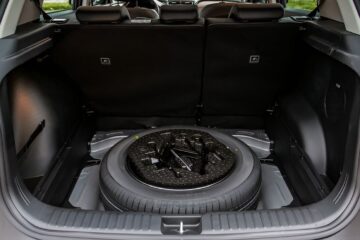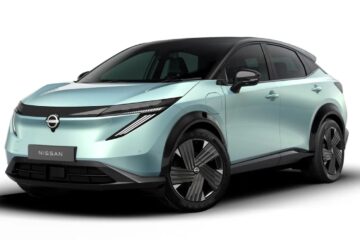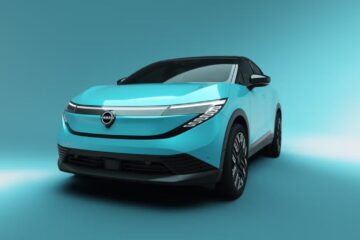Quick Highlights:
- 2,000-hp all-electric powertrain with four motors, one at each wheel, delivering all-wheel drive and active torque vectoring.
- Fighter jet–style canopy doors and a full-head-up display built into the windshield.
- Driver-focused cabin with yoke steering, Inferno Red ballistic textile, carbon fiber, and aluminum details.
- CX.R Vision Gran Turismo race version with hybrid 2.0L twin-turbo V8 + electric motors, also producing 2,000 hp.
Hopefully, the C9 will look as striking as this. The current C8—while aggressive—often feels designed to impress at first glance rather than capture timeless beauty. Even the racing flag design (essentially a skull sticker on the back window) hints at Chevy’s more playful, bold approach than refined elegance.
That said, the Corvette CX Concept gives a tantalizing peek at what Detroit’s design team envisions for the future. It made its debut at The Quail: A Motorsports Gathering during Monterey Car Week—straight out of Warren, Michigan, where GM’s famous Design Center calls home.
The CX isn’t the official next-generation Corvette (that’ll be the C9 a few years down the line). Still, it offers the clearest look so far at where Chevrolet is taking its flagship sports car: a bold blend of futuristic design, innovative features, and the Corvette spirit that fans have always loved. If that’s not enough to whet your appetite, just take a look at what’s next: the 2026 Corvette ZR1X with 1,250 horsepower and a hybrid punch, showing Corvette’s performance future is anything but ordinary.
Not the C9—But a Peek at the Future

Chevy is clear: the CX Concept isn’t the next Corvette. Think of it more as a design experiment; a way for the team to explore ideas that could influence future models—specifically the C10 that comes after the eventual C9. Some elements may remind fans of the UK and California concepts, but the Warren team came up with the CX largely on their own, refining details later with input from overseas studios.
The point isn’t to create a separate Corvette brand—it’s about pushing the Corvette name forward within Chevrolet, giving enthusiasts a taste of where the design and performance could go next.
2,000 HP and Groundbreaking Aero

Honestly, just seeing four motors crammed into a Corvette makes my jaw drop. One at each wheel—pushing a total of 2,000 horsepower—this is the kind of ridiculous number that makes you wonder if it even needs roads.
The 90-kWh battery is tucked low in the chassis, giving the car perfect balance and making it feel planted, like it’s begging to be thrown into a corner. Chevy didn’t just slap on some carbon-fiber panels for looks. The underbody channels massive airflow, the active front splitter and rear wing do work, and a vacuum fan system pulls the car to the ground.
According to GM’s Motorsports Aero Group in Charlotte, every vent, duct, and aerodynamic tweak is functional—not just for show. If the thought of a 2,000-hp electric Corvette doesn’t get your heart racing, I don’t know what will.
And in profile, the CX’s flowing aero surfaces look like something that could park next to a Rimac Nevera or McLaren Speedtail without flinching.
Canopy Doors, HUD, and a Driver-Centric Cabin

Chevy ditched regular doors on the CX Concept. The whole front canopy—windshield, roof, and hood—tilts forward so you can get in. The windshield isn’t just glass: it’s a full head-up display that shows speed, navigation, and other important info right in front of your eyes.
Inside, the seats are fixed to the carbon-fiber chassis, but you can adjust them for comfort. The steering wheel is gone—replaced with a yoke that has physical buttons and small touchscreens for the essentials.
The cabin is mostly bright Inferno Red ballistic textile, broken up with carbon fiber and milled aluminum accents. It nods to the 1959 Sting Ray Concept while feeling fully modern at the same time.
CX.R Vision Gran Turismo: Race-Ready

Chevy didn’t stop at the street car. They also revealed the CX.R Vision Gran Turismo, built specifically for Gran Turismo 7.
This track-focused beast runs a hybrid setup: a tiny 2.0-liter twin-turbo V8 making 900 hp, plus three electric motors—pushing the total output to a mind-blowing 2,000 hp.
The CX.R isn’t just about power. It gets aggressive active aero, sits lower to the ground, and rides on racing suspension. Inside, it’s stripped down to essentials—racing seats, harnesses, and a giant fixed rear wing finish the package.
For now, it’s virtual-only… but it’s a thrilling glimpse at what a future Corvette could do on the track.
Design Language and Styling

The CX Concept still screams Corvette—with its forward-leaning nose, horizontal “shine” lines, sculpted fenders, and quad taillights.
But it’s smoother, more flowing than the C8—giving a hint of what future Corvettes might look like. There’s no frunk, since parts of the carbon-fiber chassis are on full display, and the canopy doors with the HUD windshield really push the limits—mixing bold design with real-world function.
Final Thoughts

If the C8 was Corvette’s leap into mid-engine territory, the CX is its moonshot into the future. From 2,000 horsepower and next-level aerodynamics—to canopy doors, a HUD windshield, and the wild CX.R racing version—this car teases what’s coming next.
Neither the CX nor CX.R will hit production anytime soon, but they give a clear glimpse of the style, tech, and performance direction future Corvettes are heading in.
Source: Chevrolet
Read More:




